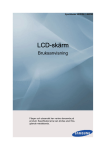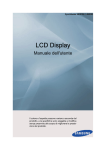Download Samsung 460DRN-A Computer Monitor User Manual
Transcript
SyncMaster 460DRN-A
LCD Display
User Manual
Introduction
Package Contents
Note
Please make sure the following items are included with your LCD Display.
If any items are missing, contact your dealer.
Contact a local dealer to buy optional items.
Unpacking
LCD Display
Manuals
Quick Setup Guide
Warranty Card
(Not available in all locations)
User's Guide
Introduction
Cables
GND Cable (3)
Others
Shock Sensor
Remote Control
Batteries (AAA X 2)
(Not available in all locations)
Sold separately
DVI Cable
LAN Cable
Your LCD Display
Front
MENU button [MENU]
Opens the on-screen menu and exits from the menu. Also use to exit the
OSD menu or return to the previous menu.
Introduction
Navigate buttons (Up-Down buttons)
Moves from one menu item to another vertically or adjusts selected menu
values.
Adjust buttons (Left-Right buttons) / Volume buttons
Moves from one menu item to another horizontally or adjusts selected
menu values. When OSD is not on the screen, push the button to adjust
volume.
ENTER button [ENTER]
Activates a highlighted menu item.
SOURCE button [SOURCE]
Switches from PC mode to Video mode. Changing the source is only allowed for external devices that are connected to the LCD Display at the
time.
[PC] → [DVI] → [AV] → [HDMI] → [MagicInfo]
PIP
Push the PIP button to turn the PIP screen On / Off.
More than one PIP cannot overlap on screen as BNC and the component
use the same terminal.
Power button [
]
Use this button for turning the LCD Display on and off.
Brightness Sensor
The product's Brightness Sensor function automatically detects the surrounding brightness using a brightness sensor and adjusts its brightness
accordingly.
Power indicator
Shows PowerSaver mode by blinking green
Note
See PowerSaver described in the manual for further information regarding
power saving functions. For energy conservation, turn your LCD Display
OFF when it is not needed or when leaving it unattended for long periods.
Remote Control Sensor
Aim the remote control towards this spot on the LCD Display.
Camera : Records and saves the event that occurred in front of the screen
when an impact is applied to the product. (Refer to the descriptions about
the shock sensor.)
Bluetooth transceiver : Enables users to connect Bluetooth devices.
Speaker
Introduction
Rear
Note
For detailed information concerning cable connections, refer to Connecting Cables under
Setup. The LCD Display 's configuration at the back may vary slightly depending on the LCD
Display model.
POWER S/W ON [ │ ] / OFF [O]
Switches the LCD Display On/Off.
POWER IN
The power cord plugs into the LCD Display
and the wall plug.
Introduction
RS232C OUT/IN (RS232C Serial PORT)
MDC(Multiple Display Control) Program Port
PC / DVI / HDMI IN [PC / DVI / HDMI
AUDIO IN] (PC/DVI/HDMI Audio Connection
Terminal (Input))
PC / DVI / HDMI IN [HDMI]
Connect the HDMI terminal at the back of
your LCD Display to the HDMI terminal of
your digital output device using a HDMI cable.
PC / DVI / HDMI IN [RGB](PC Video
Connection Terminal)
Using a D-Sub Cable (15 pin D-Sub) - PC
mode (Analog PC)
PC / DVI / HDMI IN [DVI] (PC Video Connection Terminal)
Using a DVI Cable (DVI-D to DVI-D) - DVI
mode (Digital PC)
DC OUT [5V/1.5A]
Connect this to the POWER connector of a
TV tuner box or network box.
AV IN [VIDEO] (VIDEO Connection Terminal)
Connect the [ VIDEO ] terminal of your monitor to the video output terminal of the external device using a VIDEO cable.
AV AUDIO IN [L-AUDIO-R](LCD Display
Audio Connection Terminal (Input))
AV AUDIO OUT [L-AUDIO-R] (LCD Display Audio Connection Terminal (Output))
Introduction
LAN (LAN Connection Terminal)
USB(USB Connection Terminal)
Keyboard / Mouse, Mass Storage Device
Compatible.
Note
The number of LCD Displays that can be
connected to loopout may differ depending
on the cables, signal source etc. With cables
where there is no degradation or signal
source, up to ten LCD Displays can be connected.
Circuit Breaker
A circuit-breaking unit designed to prevent
fire or electric shock caused by an electric
leakage.
Side
1.
Connect the GND wires to the bottom part of both sides of the product and then to the
back of the product as shown by figure (
2.
).
Connect the other side of the GND wires to the ground box when indoors or to the ground
pole that has been pushed into the ground when outdoors.
Introduction
Note
The ground (GND) is used to prevent product noise and to protect people from electric shock
due to electric leakage.
Remote Control
Note
The performance of the remote control may be affected by a TV or other electronic device
operating near the LCD Display , causing a malfunction due to interference with the frequency.
POWER
OFF
Number Buttons
DEL
button
+ VOL MUTE
TV/DTV
MENU
INFO
COLOR BUTTONS
TTX/MIX
STILL
AUTO
S.MODE
MDC
LOCK
SOURCE
ENTER/PRE-CH
CH/P
D.MENU
GUIDE
RETURN
Up-Down Left-Right buttons
EXIT
SRS
MagicInfo
P.MODE
Introduction
DUAL/MTS
PIP
SWAP
1.
POWER
Turns the product On.
2.
Off
Turns the product Off.
3. Number Buttons
button
4. DEL
Press to change the channel.
The "-" button operates only for DTV. It is used to select
MMS (multi-channel) for a DTV.
5. + VOL -
Adjusts the audio volume.
6.
Pauses (mutes) the audio output temporarily. This is displayed on the lower left corner of the screen. The audio
resumes if MUTE or - VOL + is pressed in the Mute mode.
MUTE
7. TV/DTV
Selects the TV and DTV mode directly.
8. MENU
Opens the on-screen menu and exits from the menu or
closes the adjustment menu.
9.
Activates a highlighted menu item.
10.
INFO
Current picture information is displayed on the upper left
corner of the screen.
11.COLOR BUTTONS
Press to add or delete channels and to store channels to the
favorite channel list in the “Channel List” menu.
12.
TV channels provide written information services via teletext.
TTX/MIX
- Teletext Buttons
For more information > TTX / MIX
13.STILL
Press the button once to freeze the screen. Press it again
to unfreeze.
14.AUTO
Adjusts the screen display automatically in PC mode. By
changing the resolution in the control panel, auto function is
performed.
15. S.MODE
When pressing this button, the current mode is displayed at
the bottom centre of the screen. The LCD Display has a
built-in high fidelity stereo amplifier. Then press the button
again to circle through available preconfigured modes.
( Standard → Music → Movie → Speech → Custom )
16.MDC
MDC Quick Launch Button.
17.LOCK
Activates or deactivates all function keys on both the remote
control and the LCD Display except for the Power and LOCK
buttons.
Introduction
18.
SOURCE
Press the button to change the input signal SOURCE.
Changing the SOURCE is only allowed for external devices
that are connected to the monitor at the time.
19.
ENTER/PRE-CH
This button is used to return to the immediately previous
channel.
20. CH/P
In TV mode, selects TV channels.
21.D.MENU
DTV menu display
22.GUIDE
Electronic Program Guide (EPG) display.
23.
RETURN
24. Up-Down Left-Right buttons
25.
26.
EXIT
SRS
Returns to the previous menu.
Moves from one menu item to another horizontally, vertically
or adjusts selected menu values.
Exits from the menu screen.
Selects SRS TruSurround XT mode.
27.MagicInfo
MagicInfo Quick Launch Button.
28. P.MODE
When you press this button, current picture mode is displayed on the lower center of the screen.
AV / HDMI / TV : P.MODE
The LCD Display has four automatic picture settings that are
preset at the factory. Then push button again to circle
through available preconfigured modes. ( Dynamic →
Standard → Movie → Custom )
PC / DVI / MagicInfo: M/B (MagicBright)
MagicBright is a feature providing the optimum viewing environment depending on the contents of the image you are
watching. Then push button again to circle through available
preconfigured modes. (Entertain → Internet → Text → Custom )
29.
DUAL/MTS
DUALSTEREO/MONO, DUAL l / DUAL ll and MONO/NICAM
MONO/NICAM STEREO can be operated depending on the
broadcasting type by using the DUAL button on the remote
control while watching TV.
MTSYou can select MTS (Multichannel Television Stereo) mode.
FM Stereo
Audio Type
MTS/S_Mode
Default
Mono
Mono
Stereo
Mono ↔ Stereo
Manual
Change
Introduction
SAP
30. PIP
Mono ↔ SAP
Mono
Every time you press the button, a PIP screen appears.
- This fuction does not work for this LCD Display.
31.SWAP
Swaps the contents of the PIP and main image. The image
in the PIP window will appear on the main screen, and the
main screen image will appear in the PIP window.
- This fuction does not work for this LCD Display.
Troubleshooting
Self-Test Feature Check
Note
Check the following items yourself before calling for assistance. Contact a Service Center for
problems that you cannot solve by yourself.
Self-Test Feature Check
1.
Turn off both your computer and the LCD Display.
2.
Unplug the video cable from the back of the computer.
3.
Turn on the LCD Display.
The figure shown below ("Check Signal Cable") appears on a black background when
the LCD Display is working normally even though no video signal is detected: While in
the Self-Test mode, the LED power indicator remains green and the figure moves around
on the screen.
4.
Turn off your LCD Display and reconnect the video cable; then turn on both your computer and the LCD Display
If your LCD Display screen remains blank after using the previous procedure, check your
video controller and computer system; your LCD Display is functioning properly.
Warning Messages
You can even view the screen at a resolution of 1366 x 768. However, you will receive the
following message for a minute; You can choose to change the screen resolution or stay in
the current mode during that time. And if the resolution is more than 85Hz, you will see the
black screen because the LCD Display does not support over 85Hz.
Note
Refer to Specifications > Preset Timing Modes for the resolutions or frequencies supported
by the LCD Display.
Maintenance and Cleaning
1) Maintaining the LCD Display Case.
Clean with a soft cloth after disconnecting the power cord.
Troubleshooting
•
Do not use benzene, thinner or other flammable substances, or a wet cloth.
•
We recommend that a SAMSUNG cleansing agent
is used to prevent damage to the screen.
2) Maintaining the Flat Panel Display Screen.
Clean with a soft cloth (cotton flannel) smoothly.
•
Never use acetone, benzene or thinner.
(They may cause flaws or deformation of the screen
surface.)
•
The user will be required to pay costs and related
expenses for repairing damages caused.
Symptoms and Recommended Actions
Note
A LCD Display recreates visual signals received from the computer. Therefore, if there is a
problem with the computer or the video card, this can cause the LCD Display to become
blank, have poor coloring, become noisy, and video mode not supported, etc. In this case,
first check the source of the problem, and then contact a Service Center or your dealer.
1.
Check if the power cord and the video cables are properly connected to the computer.
2.
Check if the computer beeps more than 3 times when booting.
(If it does, request an a service for the main board of the computer.)
3.
If you installed a new video card or if you assembled the PC, check if you installed the
Adaptor(video).
4.
Check if the scanning ratio of the video screen is set to between 50 Hz ~ 85 Hz.
(Do not exceed 60Hz when using the maximum resolution.)
5.
If you have problems in installing the Adaptor (video) driver, boot the computer in Safe
Mode, remove the Display Adaptor in the "Control Panel -> System -> Device Administrator" and then reboot the computer to reinstall the Adaptor (video) driver.
Check List
Note
•
The following table lists possible problems and their solutions. Before calling for assistance, check the information in this section to see if you can remedy any problems for
yourself. If you do need assistance, please call the phone number on the Information
section or contact your dealer.
•
For more network-related information, refer to the MagicInfo Troubleshooting section.
Problems related to the Installation (PC Mode)
Note
Problems related to the LCD Display installation and their solutions are listed.
Q:
The LCD Display screen flickers.
Troubleshooting
A:
Check if the signal cable between the computer and the LCD Display is securely connected.
Problems related to the Screen
Note
Problems related to the LCD Display screen and their solutions are listed.
Q:
The screen is blank and the power indicator is off.
A:
Ensure that the power cord is firmly connected and the LCD Display is on.
Q:
"Check Signal Cable" message.
A:
Ensure that the signal cable is firmly connected to the PC or video sources.
A:
Ensure that the PC or video sources are turned on.
Q:
"Not Optimum Mode" message.
A:
Check the maximum resolution and the frequency of the video adaptor.
A:
Compare these values with the data in the Preset Timing Modes Chart.
Q:
The picture rolls vertically.
A:
Check if the signal cable is securely connected. Re-connect it, if necessary.
Q:
The image is not clear; picture is blurred.
A:
Run Frequency Coarse and Fine tuning.
A:
Turn on again after removing all accessories (video extension cable, etc.)
A:
Set the resolution and frequency to the recommended ranges.
Q:
The picture image is unstable and shakes.
A:
Check if the resolution and frequency set for the computer video card falls in the range
supported by the LCD Display. If not, reset them referring to the current Information
under the LCD Display menu and Preset Timing Modes.
Q:
Ghost images are shown in the picture.
A:
Check if the resolution and frequency set for the computer video card falls in the range
supported by the LCD Display. If not, reset them referring to the current Information
under the LCD Display menu and Preset Timing Modes.
Q:
The image is too light or too dark.
A:
Adjusts the brightness and contrast.
(Refer to the Brightness, Contrast)
Q:
The screen color is inconsistent.
A:
Adjust color using Custom under OSD Color Adjustment menu.
Q:
The color image is distorted by dark shadows.
A:
Adjust color using Custom under OSD Color Adjustment menu.
Troubleshooting
Q:
The color white is poor.
A:
Adjust color using Custom under OSD Color Adjustment menu.
Q:
The power Indicator blinks green.
A:
The LCD Display is currently saving the changes made to the settings to the OSD
memory.
Q:
The screen is blank and the power indicator light is steady green or blinks every 0.5 or
1 seconds.
A:
The LCD Display is using its power management system.
A:
Press a key on the keyboard.
Q:
The screen is blank and it is blinking.
A:
If you see the "TEST GOOD" message on the screen when you pressing the MENU
button, check the cable connection between the LCD Display and the computer to ensure that the connector is properly connected.
Problems related to Audio
Note
Problems related to audio signals and their solutions are listed below.
Q:
No sound.
A:
Ensure that the audio cable is firmly connected to both the audio-in port on your LCD
Display and the audio-out port on your sound card.
A:
Check the volume level.
Q:
The sound level is too low.
A:
Check the volume level.
A:
If the volume is still too low after turning the control to its maximum, check the volume
control on the computer sound card or software program.
Q:
The sound is too high or too low.
A:
Adjusts the Treble and Bass to the appropriate levels.
Problems related to the Remote Control
Note
Problems related to the remote control and their solutions are listed.
Q:
The remote control buttons do not respond.
A:
Check the polarities (+/-) of the batteries.
A:
Check if the batteries are empty.
A:
Check if the power is on.
A:
Check if the power cord is securely connected.
A:
Check if a special fluorescent or neon lamp is on in the vicinity.
Troubleshooting
Problems related to MagicInfo
Note
Making a Bootable USB Flash Disk.
Q:
Making a Bootable USB Flash Disk
A:
1) You can turn a common 512-MB or bigger USB storage media into a bootable disk
using a USB bootable disk creation tool. (For example, the HP USB Disk Storage Format Tool)
A:
2) Copies the OS ghost image and executables to your USB disk.
A:
3) Enter the BIOS menu of your set by pressing the F2 key in the BIOS logo screen.
Then, enable the USB Boot First option by selecting that option and pressing the Enter
key in the Boot menu.
A:
4) Switch your set on while your USB disk is connected and boot up in DOS mode.
A:
5) Run C:\ghost.exe and choose Local → Partition → From Image from the menu.
Choose the ghost image to update your USB disk with and choose the target disk.
A:
6) When the ghost image update finishes, the set will be rebooted automatically.
Q:
How can I change the frequency?
A:
The frequency can be changed by reconfiguring the video card.
Q&A
Note
That video card support can vary, depending on the version of the driver used. (Refer
to the computer or the video card manual for details.)
Q:
How can I Adjusts the resolution?
A:
Windows XP:
Set the resolution in the Control Panel → Appearance and Themes → Display → Settings.
A:
Windows ME/2000:
Set the resolution in the Control Panel → Display → Settings.
* Contact the video card manufacturer for details.
Q:
How can I set the Power Saving function?
A:
Windows XP:
Set the resolution in the Control Panel → Appearance and Themes → Display → Screen
Saver.
Set the function in the BIOS-SETUP of the computer. (Refer to the Windows / Computer
Manual).
A:
Windows ME/2000:
Set the resolution at the Control Panel → Display → Screen Saver.
Troubleshooting
Set the function in the BIOS-SETUP of the computer. (Refer to the Windows / Computer
Manual).
Q:
How can I clean the outer case/LCD Panel?
A:
Disconnect the power cord and then clean the LCD Display with a soft cloth, using either
a cleaning solution or plain water.
Do not leave any detergent or scratches on the case. Do not let any water enter the
LCD Display.
Q:
How can I play the video?
A:
The video supports the MPEG1 and WMV codecs only. Install the corresponding codec
to play the video. Note that some of the codecs can be incompatible.
Note
Before calling for assistance, check the information in this section to see if you can remedy
any problems yourself. If you do need assistance, please call the phone number on the Information section or contact your dealer.


























